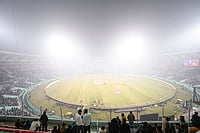In a celestial performance that could rival the grandest ballet, India's Aditya-L1 solar mission spacecraft has gracefully pirouetted its way into the cosmos, capturing a stellar array of data to satiate the curiosity of scientists worldwide. The Indian Space Research Organisation (ISRO) recently revealed that the spacecraft has embarked on a remarkable journey, acquiring invaluable data to fathom the intricate dance of particles enveloping our planet.
The enchanting spectacle commenced with sensors aboard India's pioneering solar observatory commencing measurements of supra-thermal and energetic ions and electrons. This captivating performance unfolded at distances exceeding an astonishing 50,000 kilometers from Earth, a celestial stage that promises to unveil the secrets of the cosmic choreography.
ISRO, headquartered in the vibrant city of Bengaluru, expressed their excitement in a vivid post on the social media platform X. "This data helps scientists analyze the behavior of particles surrounding Earth," they gleefully proclaimed.
At the heart of this cosmic performance lies the Supra Thermal & Energetic Particle Spectrometer (STEPS) instrument, an essential member of the Aditya Solar Wind Particle EXperiment (ASPEX) payload. These STEPS measurements promise to persist throughout the Aditya-L1 mission's cruise phase as it ventures towards the Sun-Earth L1 point. Even after reaching its intended orbit, the spacecraft will continue to collect this celestial data.
This captivating data, collected in the vicinity of the L1 point, will serve as a window into the origin, acceleration, and anisotropy of solar wind and space weather phenomena, ISRO elaborated. The creation of STEPS itself is a testament to scientific collaboration, as it was developed by the Physical Research Laboratory with support from the Space Application Centre in Ahmedabad.
The Aditya-L1 mission, launched with great aplomb on September 2 using the PSLV-C57 rocket, carries a total of seven distinct payloads. Four of these instruments will diligently observe the Sun's radiant light, while the remaining trio will measure in situ parameters of the plasma and magnetic fields.
Aditya-L1 will ultimately be stationed in a graceful halo orbit around Lagrangian Point 1 (L1), a mesmerizing location 1.5 million kilometers from Earth, gazing steadfastly in the direction of the Sun. In this unique vantage point, it will revolve in perfect harmony with the Sun, affording continuous observation.
STEPS, the star of this celestial ballet, boasts six sensors, each poised in different directions, measuring supra-thermal and energetic ions ranging from 20 keV/nucleon to 5 MeV/nucleon, along with electrons exceeding 1 MeV. These mesmerizing measurements are gracefully performed using both low and high-energy particle spectrometers.
As STEPS was activated on September 10, it waltzed into action at a distance far greater than 50,000 kilometers from Earth, equivalent to more than eight times the Earth's radius, placing it firmly beyond Earth's radiant belt region, as gracefully described by ISRO.


























